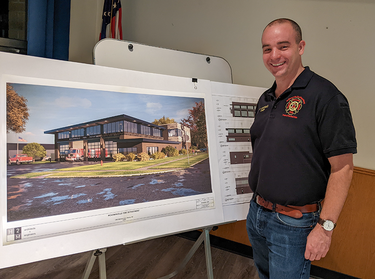‘Nothing elaborate’: McKownville hopes to build new $9M firehouse
GUILDERLAND — The all-volunteer fire department in McKownville wants to tear down its 56-year-old station and, in nearly the same footprint, build a new one for about $9 million.
“We’ll still be the smallest station in town yet we’re the second busiest,” said Jim White, who chairs the board for the McKownville Fire District.
He spoke on Wednesday evening to about 20 people who gathered at the firehouse, located at the corner of Route 20 and Brookwood Avenue, to hear a presentation from H2M architects, based in Troy.
A second public presentation is planned ahead of a vote in early 2024. If voters approve the project, construction is expected to take 14 months.
Since the old firehouse would be torn down, White said the hope is to operate from a temporary structure on town-owned property across the street. “We can’t put that into a bond,” he said. “We’ll pay for that with cash out of our budget.”
White said he’d started working on the project 10 years ago. Having gotten an initial, undisclosed estimate, he said, “After we got off the floor from fainting, we came back with a more efficient space.”
The plan calls for going from the current three bays to four for fire apparatus and also adds a second story. But, White stressed, there is “nothing elaborate.”
Rather than the many offices featured in other firehouses, White said, there would be one conference room to allow for social distancing, a lesson learned during the pandemic.
The primary goal, White said, is: “We want to keep our firefighters safe.”
Dennis Ross, with H2M, said, “Cancer prevention is probably the single most important issue.” The new firehouse, he explained, is designed so that carcinogens are contained. There would be a separate entry for the public.
Ross also said of the current firehouse, “This building is not salvageable.”
Presentation
Aubrey Dunn, a staff designer at H2M, said that repairs and additions to the current firehouse would not be cost-effective. Rebuilding on the same site, Dunn said in her presentation, would save on land costs and should last the department for 50 to 75 years.
She showed pictures of cramped quarters and unsafe storage of gear.
Part of the new space will be used for in-station active training since the department wants to attract and keep volunteers.
The building was designed with sustainability in mind, said Dunn, noting on-site drainage and stormwater management, use of local materials, indigenous landscaping, oil-water separation for trench drains, and a grease interceptor for kitchen waste.
The proposed size would be 12,375 square feet compared to an average fire-station size nationwide of about 17,000 square feet, Dunn said.
“We went for a modern look with large windows,” said Ross, which will let in natural light.
By the numbers
The McKownville volunteers answer between 250 and 275 calls each year.
So far this year, they have responded to 277 calls: 166 were for fires including structure, vehicle, and brush fires; 30 were for hazardous conditions; 14 were for motor-vehicle accidents; and 17 were answering special requests like basement pump-outs.
The McKownville fire district, in addition to covering the many residences and small businesses in the hamlet up to the Albany city line, includes all of Stuyvesant Plaza and Executive Park, the Woodscape housing development, 45 percent of the University at Albany uptown campus, and a portion of Crossgates Mall.
Each volunteer is required to complete 140 hours of training before becoming an interior firefighter. Each year, additional training is required for tasks like extrication or dealing with hazardous waste.
The anticipated cost for the new station construction and site work is $9,050,000, to be financed through a 30-year bond.
White said the fire district serves about 900 households. The current fire tax rate in McKownville is $1.58 per $1,000 of assessed value.
The estimated cost of the new firehouse would be $1.48 per $1,000 of assessed property value. The median assessed home value in McKownville is $253,912. So those average homeowners would be paying $31.31 per month for the new firehouse — or $375.72 per year.
“We’re all taxpayers as commissioners,” said White. “We’re sensitive to it,” he said of the costs. “It’s time we took into consideration the safety and welfare of the volunteers.”
Dunn displayed a slide showing how much taxpayers save by having volunteers rather than paid firefighters. A 2023 report put out by the Firefighters of the State of New York found that volunteer departments save New York state taxpayers $3.8 billion per year.
Of the 2,166 fire departments across the state, 1,549 are staffed by volunteers. The average annual cost savings per department is $1.8 million in salary and benefits alone.
White said that he had calculated for McKownville, “If I had a minimum staff of three paid members per shift, it would cost $2 million per year.”
Outside of cities, most firefighting is done by volunteers, according to a 2017 report by the New York State comptroller. There are over 90,000 volunteers and about 18,000 paid career firefighters in the state, the report says. Over the last three decades, the number of volunteer firefighters in New York State has declined by more than 20,000.
“Every volunteer fire department in the country is hurting for members,” said White.
But, he went on about McKownville, noting it even has volunteers from Albany, which has a paid department: “We are a great feeder system to the volunteer fire system.”
History
The McKownville Fire Department is more than a century old, founded in 1918. The company’s original firehouse was built on donated land on Arcadia Avenue. In July 1934, voters approved a bond issue of $12,000 for it, by a vote of 87 to 30. It still stands today.
As the district grew, in January 1967, voters approved a bond issue of $285,000 to build a new firehouse and buy a new fire truck, by a vote of 232 to 17.
In 2014, White explained to the crowd on Wednesday, “We hired an engineering company to remodel.” The plan was to build a second story and modernize the current building, bringing it up to code.
“That was a complete failure,” he said.
White had told The Enterprise in 2016 that the fire trucks vie for space with the firefighters’ personal-equipment lockers. “We’ve had trucks back into the lockers,” he said. “It’s a situation we feel we have to change.”
The building had gone through multiple makeovers but had gotten to the point where it no longer met the needs of a modern fire station, the five commissioners wrote in a 2016 letter to fire-district residents. More space was needed to meet the expanded federal and state requirements for firefighting equipment, and the building’s footprint cannot be substantially enlarged, they wrote.
The 2016 plan was, for $3.2 million, to about double the size of the firhouse to nearly 13,000 square feet by adding a second story.
The public was supportive, carrying the measure by a vote of 95 to 46.
Fire district elections typically draw few voters. “Despite the critical nature of the service and the importance which residents attach to fire protection services, the low levels of participation — less than 1 percent of the registered voters of the district in almost all cases — suggests voter apathy,” according to an October 2022 report from the Rockefeller Institute of Government.
“Moreover,” the report goes on, “according to multiple media accounts, most of the votes cast in these elections are cast by members of the fire department and their families. Most residents, in other words, do not bother to vote in fire district elections — possibly because they are satisfied with the level of service in their area, but more likely due to the opaqueness of the process and low levels of awareness.”
Despite the 2016 measure passing, White said this week, “We got one substandard bid.”
In July 2017, White had told the Guilderland Planning Board, which approved the project, “Our bids came back higher than our estimated costs, so we’ve got to go back and figure out what we’re going to do.”
Mickey Cleary, who was then a planning board member, told White at the 2017 meeting, “I think what needs to happen, if you need more money, you go back and get approval for more money. Don’t shortchange yourselves for what you guys are doing for our community.”
Cleary, now an Albany County legislator, echoed those sentiments at Wednesday’s meeting. “If you need other stuff, please add it … It’s going to be another 30, 35 years to do it,” said Cleary, adding, “It needs to move forward … It’s been too long.”
In addition to asking questions, several of the attendees on Wednesday had praise for the volunteers or for their proposed project.
One pointed out that homeowners’ fire insurance would go up if there weren’t a nearby fire station. Another pointed out that it is difficult to get modern equipment to fit in the old bays.
Eight fire departments provide coverage for the town of Guilderland and five of them — McKownville, Westmere, Guilderland, Guilderland Center, and Fort Hunter — focus solely on the town. Altamont also has a fire department which focuses on the village.
While the McKownville, Westmere, and Guilderland firehouses are located within a five-mile stretch on Western Avenue, Guilderland Center’s firehouse is on School Road and Fort Hunter’s is on Carman Road.
Last December, Fort Hunter passed, by a 41-to-2 vote, a $1.5 million proposal for repairs to its five-bay firehouse built two decades ago for $4.5 million.
White said that, even though McKownville’s fire department is among the busiest — “you guys hear the sirens,” he said — he went on, “We’re the smallest, dingiest building.”
“Nine million is a freaking large amount of money,” said one woman listening to the presentation who cried as she spoke of firefighters “pulling some kids out of a burning building.” The man seated next to her handed her a red bandana for her tears.



